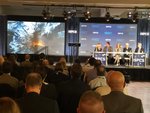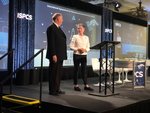Wind: 11.5 mph, W
Welcome to our new web site!
To give our readers a chance to experience all that our new website has to offer, we have made all content freely avaiable, through October 1, 2018.
During this time, print and digital subscribers will not need to log in to view our stories or e-editions.


The International Symposium for Personal and Commercial Spaceflight (ISPCS), held at the New Mexico Farm & Ranch Heritage Museum Oct. 9-10, brought together experts to discuss logistics in the industry.
Attendees learned about the regulation process, the “Ups and Downs” of flying commercial spaceflight and socioeconomic development fueled by commercial space exploration. They also heard updates about companies Virgin Galactic, The Spaceship Company, Spaceport America, Vector Launch Inc., NASA and Made in Space Inc.
ISPCS Curator Pat Hynes opened the conference.
“The definition of the commercial space industry continues to evolve,” she said. “This evolution and expansion define the industry. We have to [expand] in order to stay a viable industry.”
Hynes said a component of viability is partnerships: 14 sovereign nations have partnered on the International Space Station (ISS) for 19 years. She said 577 people have gone to space, more than half to ISS.
“Because we have a destination, we are now bringing more people into the space industry all the time,” she said. “This puts more burden on the FAA because better transportation [means] better resupply to the destination.”
NASA recently developed four strategic themes as part of a new plan for space exploration – discover, explore, develop, enable.
“What does it really mean?” she asked, rhetorically. “For people who develop their technologies on the ISS, it means they keep their intelectual property. This will further increase demand for the facility that rivals any single achievement of mankind.”
Transportation systems to space are essential to the industry’s growth, she said, in part because of human needs.
“Humans like to be with each other, and we definitely need each other in space. In order to do human things like breathe, eat, sleep and go back and forth we need a wide array of accessible infrastructure. More humans equal more demand, more demand equals more supply.”
Hence, this year’s theme of “We’ll get you there,” she said.
“We live in a country governed by the rule of law and we work in an industry governed by the laws of physics,” Hynes said. “Space policy is a give-and-take business, gravity not so much. Space policy directive rules are being revised as we speak.”
Elva K. Österreich may be reached at elva@lascrucesbulletin.com.